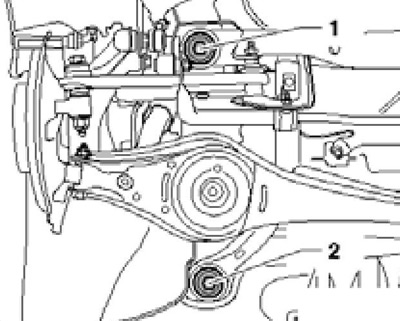FWD Models
1. Remove the rear wheels and the rear of the exhaust system (see chapter 4).
2. Remove rear suspension springs (see Section 12).
3. If there is a suspension height sensor, disconnect the connector of its electrical wiring (1 per resist. illustrations) and loosen the holder (3) wiring.

9.3 Connector (1) and fasteners (2) rear suspension height sensor
4. Disconnect the ABS rear wheel sensor connectors (1 in Illustration 3.19 of Chapter 8).
5. Release the wiring from the bracket (see resist. illustration).

9.5 ABS sensor wire on bracket
6. Push the lever on each side of the car (2 to resist. illustrations) in the direction of the arrow and unhook the cables (3) parking brake. Loosen the latches (1) cables on brackets.

9.6 Disconnecting the parking brake cable
7. Release the parking brake cables from the brackets (3 in Illustration 3.23 of Chapter 8) on the trailing arms and pull out the cables.
8. Turn out the bottom bolts of fastening of shock-absorbers (arrow in Illustration 3.19 of Chapter 8).
9. Remove the clips (1 per resist. illustrations) brake lines.

9.9 Brake line clamps
10. Remove brake calipers (see chapter 9), without disconnecting the brake hoses from them, and hang them on the body parts on a wire so that the brake hoses are not strained.
11. Mark the mounting position of the trailing arm brackets relative to the body and unscrew the bolts (arrows on resist. illustrations).

9.11 Bracket bolts
12. Fix the car on the legs of the lift with belts T10038 (see illustration 2.3) and install the VAG1383/A transmission jack with the VAG1359/2 universal support under the subframe, placing a wooden block between them (see resist. illustration). Attach the subframe to the jack.

9.12 Jacking up the rear subframe
13. Turn out bolts (1 or 2 per resist. illustrations) on both sides.

9.13 Subframe bolts (left-hand side)
14. Fix the position of the subframe by screwing in two centering pins T10096 (see resist. illustration) with a force of not more than 20 Nm. Remove the two remaining subframe bolts (see illustration 9.13) and gently lower it about 30mm, keeping an eye on the brake lines and wiring.

9.14 Fixing the position of the subframe
15. Release the brake line from the holders on the subframe and lower it together with the connected suspension parts.
16. Installation is carried out in the reverse order. Finally, do a road test (see chapter 1), check the position of the steering wheel and adjust the angles of the rear wheels (see Part D).
AWD Models
17. Follow the steps described in paragraphs 1-11.
18. Disconnect the wiring connector (2 in Illustration 9.3 of Chapter 8) Haldex clutch control unit between the rear suspension and the body.
19. Check for color marks on the flexible disk of the cardan shaft and on the flange of the Haldex coupling (see illustration 7.9 of chapter 8). Apply these marks as needed. Turn out bolts of fastening of the propeller shaft to the Haldex coupling flange (see Figure 7.10 Chapter 8).
20. Loosen the bolts of the middle bearing of the cardan shaft by two turns (see Figure 7.11 Chapter 8) and secure the shaft by placing a wooden block between it and the cross member of the central tunnel (see resist. illustration). Pull the cardan shaft as far forward as possible.

9.20 Bar between cardan shaft and cross member
21. Secure the car to the legs of the lift with straps (see illustration 2.3).
22. Install the VAG1383/A transmission jack with the VAG1359/2 universal support under the subframe, placing a wooden block between them (see illustration 9.12). Attach the subframe to the jack.
23. Remove the bolts (1 and 2 on resist. illustrations) on both sides.

9.23 Subframe bolts
24. Lock the position of the subframe by screwing in two centering pins T10096 in turn (see illustration 9.14) with a force of not more than 20 Nm. Remove the two remaining subframe bolts and carefully lower it about 30mm, keeping an eye on the brake lines and wiring.
25. Release the brake line from the holders on the subframe and lower it together with the connected suspension parts.
26. Installation is carried out in the reverse order. Finally, do a road test (see chapter 1), check the position of the steering wheel and adjust the angles of the rear wheels (see Part D).
